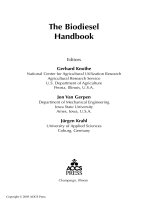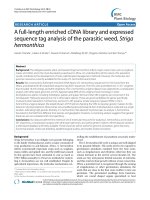Fforestfach tyre fire BKK full version
Bạn đang xem bản rút gọn của tài liệu. Xem và tải ngay bản đầy đủ của tài liệu tại đây (1.78 MB, 32 trang )
Public Health Wales
Fforestfach tyre fire:
the public health
response
Professor David Russell, The WHO Collaborating Centre for Chemical Incidents
Public Health Wales
Background – tyre fires
Health Protection Agency
• EU Landfill Directive bans disposal of tyres, whole or
shredded to landfill – have to be recycled
• 10 large tyre dumps across the UK contain 13m tyres
• Total UK annual estimates vary – approximately 500,000t
- 2011 – Swansea
- 2010 – Wem (Shropshire) & Mexborough (Yorkshire)
- 2009 – Baglan, Port Talbot
• SIGNIFICANT PUBLIC HEALTH RISK
• ILLEGAL STOCKPILING INCREASING PROBLEM
Location
• />Public Health Wales
Fforestfach,Swansea
• />Public Health Wales
Public Health Wales
Public Health Wales
Public Health Wales
Fforestfach tyre fire
Health Protection Agency
• Tyre fire at warehouse on industrial estate (16/6/11)
• Source material est. 5,000 tonnes of tyre flock
• Dark, dense smoke plume
• Burned for over 3 weeks
• Air quality monitoring established at outset (AQC)
• Met conditions varied over time
• Plausible that all within a 2km radius were exposed
• Novel fire fighting techniques required
•
Major incident declared
Questions; Hazard Identification
• What chemicals could have been
released?
• What are the hazardous properties?
Public Health Wales
Questions: Hazard
Characterisation
• What properties of the chemical(s) have
the potential to cause adverse health
effects?
• Do guidelines from international
organisations exist for the chemical(s)?
• What assumptions are made about
exposure and dose?
• Do these assumptions reflect the local
population?
Public Health Wales
Sensitive Receptors
Areas and specific buildings under
plume that may have residents more
sensitive to pollutants including
• Schools / nurseries (children)
• Care Homes (elderly / infirm)
• Hospitals / health centres (ill/pregnant)
Other Receptors
• General Residential Communities
• Commercial Properties
Schools
Sheltered Complexes
Nursing Homes
Receptors
X
Question: Exposure
assessment
• How could people come into contact
with the chemicals?
• How much exposure is likely to
occur?
• For how long is exposure likely to
occur?
Public Health Wales
Use Met and chemical data to predict
direction and distance travelled by
plume incorporating
• Wind direction / Speed
• Ambient Temperature / Pressure
• Chemical Properties
• Buoyancy of plume
• Rainfall Deposition
Used to help site monitors and inform
messages and decisions
Pathways
Health Protection Agency
Public Health Wales
Public Health Wales
Air quality monitoring
General principles:
• Environmental monitoring (sampling) during acute chemical
incidents informs public health risk assessment
• Monitoring provides a measure of the environmental
concentrations of selected chemicals over time
• Monitoring is most useful when carried out at receptor
locations (i.e. places where people are - exposed)
• Environmental concentrations can be compared to health-
based exposure standards
• Monitoring can provide reassurance
Health Protection Agency
Particulates
• PM10 near source over 6000 μg/m
3
• Peaks above Trigger 1 and Trigger 2
• 24 hour means exceeding Trigger 1
• No 24 hour means above Trigger 2
•Plume shifting with changing wind direction
reducing exposure time for each area affected
Gases
• Odours detected over very wide areas
•
No values above AEGL 2
Asbestos
• Controls for safe removal and disposal of wastes
Results and observations
Monitoring Data – Particulates (Running 24 Hour Means)
PM
10
monitoring results
Air Quality Index
Band PM10 (ug/m3) Impact/mitigation
Low <50 Low-no restriction of
activities
Moderate 51-75 Sensitive individuals
reduce strenuous
outdoor activity
outdoors
High 76-100 Sensitive individuals
reduce activity + those
experiencing
discomfort
Very high >100
Sensitive individuals
avoid physical exertion
plus reduction in others
who experience
Chemical Hazards & Poisons Division (Cardiff)
www.hpa.org.
k
Threshold Levels
•Action levels developed in 2009.
•Guidelines based on scientific theory
•24-hour average values of 160-
180ug/m
3
identified as levels to
consider evacuation vs sheltering.
•24-hour values of 320-360 ug/m3
identified as threshold for which
immediate public health intervention
may be needed.
•
Based on prolonged duration i.e.
d k
Chemical Hazards & Poisons Division (Cardiff)
www.hpa.org.
k
Health Based Standards / Triggers
Particulates – 24 hour running means
• Air Quality Standard 50 μg/m
3
(Chronic Risk)
• UK Dept Health Pollution Index (Sub-
chronic Risk)
Irritant Gases
• Acute Exposure Guideline Levels
(USEPA)
10 – 60 minute exposure AEGL2*
Band Index PM
10
(ug/m
3
running 24
hr mean)
Sulphur
Dioxide
(ug/m
3
15
min mean)
Carbon
Monoxide
(mg/m
3
8
hour mean)
Low 1 0-21 0-88 0-3.8
2 22-42 89-176 3.9-7.6
3 43-64 177-265 7.7-11.5
Moderate 4 65-74 266-354 11.6-13.4
5 75-86 355-442 13.5-15.4
6 87-96 443-531 15.5-17.3
High 7 97-107 532-708 17.4-19.2
8 108-118 709-886 19.3-21.2
9 119-129 887-
1063
21.3-23.1
Very
High
10
130 or
more
1064 or
more
23.2 or
more
Department of Health
*AEGL-2 is the airborne concentration above which it is predicted that the general population, including susceptible individuals,
could experience irreversible or other serious, long-lasting, adverse health effects or an impaired ability to escape.
Data interpretation
Questions: Risk
Characterisation
• How do the concentrations compare
with the guideline values?
Public Health Wales
Public Health Wales
Potential emissions
• Potential impacts on health and environment
• Gaseous pollutants, smoke and particulates
• Plume constituents vary – uncertainties about nature of
burning material, fire characteristics, combustion
temperature, oxygen availability, ventilation
• Generally: PM; SO2; heavy metals; CO; PAHs; organics
e.g. benzene, phenols, styrene; inorganic irritants e.g.
Polychlorinated dibenzo-p-dioxins and dibenzofurans
Health Protection Agency
Public Health Wales
Public health context
• PM – respiratory and cardiovascular morbidity and mortality, child
health and development, birth outcomes?
• Combination of PM-borne, persistent organics and metals can lead
to biological interactions and cancers
• SO2 – constriction of airways of lung
• CO reduced capacity of red blood cells to carry oxygen
• Benzene – known carcinogen (increased leukaemia risk)
• Chromium, nickel, arsenic – known carcinogens
• PAHs – toxic, carcinogens, mutagens and reproductive toxins; BaP
exposure linked to lung and skin cancer
• Dioxins/furans – toxic; TCDD is a carcinogen; reproductive impacts
Health Protection Agency
Questions: Risk mitigation
• What could be done to reduce the
risk to the public?
Public Health Wales
Recovery
Public Health Wales
Public Health Wales
Public Health Wales









